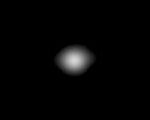Adrastea (moon)
- For the asteroid, see 239 Adrastea. For the moon of Jupiter known by this name 1955-1975, see Ananke (moon).
 Image of Adrastea taken by Galileo's solid state imaging system between November 1996 and June 1997. | |
| Discovery | |
|---|---|
| Discovered by | David C. Jewitt G. Edward Danielson |
| Discovery date | July 8, 1979 |
| Orbital characteristics | |
Mean orbit radius | 129,000 km[1][2] |
| Eccentricity | 0.0015[1][2] |
| 0.29826 d (7 h 9.5 min)[1][2] | |
Average orbital speed | 31.378 km/s[3] |
| Inclination | 0.03° (to Jupiter's equator)[1][2] |
| Satellite of | Jupiter |
| Physical characteristics | |
| Dimensions | 20×16×14 km[4] |
Mean radius | 8.2 ± 2.0 km[4] |
| Volume | ~2,345 km³[3] |
| Mass | ~2×1015 kg[3] |
Mean density | 0.86 g/cm³ (assumed) |
| ~0.002 m/s² (0.0004 g)[3] | |
| ~0.008 km/s[3] | |
| synchronous | |
| zero[4] | |
| Albedo | ~0.1 ± 0.045[4] |
| Temperature | ~122 K |
Adrastea (ad'-rə-stee'-ə, /ˌædrəˈstiːə/, Greek Αδράστεια) or Jupiter XV, is the second of Jupiter's known moons (counting outward from the planet). It was discovered by David C. Jewitt and G. Edward Danielson in Voyager 2 probe photographs taken in 1979 and received the designation S/1979 J 1.[5][6] In 1983, it was officially named after the mythological Adrastea,[7] who was a daughter of Jupiter and Ananke.
Adrastea was the first natural satellite to be discovered from images taken by an interplanetary spacecraft, rather than through telescopic photography.
Physical characteristics
Adrastea has an irregular shape and measures 20x16x14 km³ across.[4] The bulk composition and mass of Adrastea are not known, but assuming that its mean density is like that of Amalthea (~0.86 g/cm³)[8] its mass can be estimated at ~2×1015 kg. Amalthea's density implies that that moon is composed of water ice with a porosity of 10-15%, and Adrastea may be similar.[8]
No surface details of Adrastea are known, due to the low resolution of available images.[4]

Orbit
Adrastea is the smallest and second closest member of the inner Jovian satellite family. It orbits Jupiter at a radius of ~129,000 km (1.806 Jupiter radii) within the planet's Main Ring. The orbit has very small eccentricity ~0.0015 and inclination ~ 0.03° relative to the equator of Jupiter.[2]
Due to tidal locking, Adrastea rotates synchronously with its orbital period, keeping one face always looking toward the planet. Its long axis is aligned towards Jupiter, this being the lowest energy configuration.[4]
The orbit of Adrastea lies inside Jupiter's synchronous orbit radius (as does Metis’s), and as a result, tidal forces are slowly causing its orbit to decay so that it will one day impact Jupiter. If its density is similar to Amalthea's then its orbit would actually lie within the fluid Roche limit. In any case, however, since it is not breaking up, it must still lie outside its rigid Roche limit.[2]
Relationship with Jupiter's rings
Adrastea is the largest contributor to material in Jupiter's rings. This material appears to consist primarily of material that is ejected from the surfaces of Jupiter's four small inner satellites by meteorite impacts. It is easy for the impact ejecta to be lost from the satellites into space because the satellites' surfaces lie fairly close to the edge of their Roche spheres due to their low density.[2]
It appears that Adrastea is the most copious source of this ring material, as evidenced by the most dense ring (the Main Ring) being located at and within Adrastea's orbit.[9] Precisely, the orbit of Adrastea lies near the outer edge of Jupiter's Main Ring. The exact location of the visible ring material depends on the phase angle of the images: in forward-scattered light Adrastea is firmly outside the Main Ring,[10] but in back-scattered light (which reveals much bigger particles) there appears to also be a narrow ringlet outside Adrastea's orbit.[2]
Exploration
Adrastea was discovered in Voyager 1 and 2 images, but appeared only as a dot.[6] The Galileo spacecraft was able to determine its shape, but the images remain poor.[4]
See also
References
- ^ a b c d Evans, M.W. (2002). "The Orbits of Metis and Adrastea: The Origin and Significance of their Inclinations". Bulletin of the American Astronomical Society. 34: 883.
{{cite journal}}: Unknown parameter|coauthors=ignored (|author=suggested) (help) - ^ a b c d e f g h Template:Harvard reference
- ^ a b c d e Calculated on the basis of other parameters
- ^ a b c d e f g h Thomas, P.C. (1998). "The Small Inner Satellites of Jupiter". ICARUS. 135: 360–371. doi:10.1006/icar.1998.5976.
{{cite journal}}: Unknown parameter|coauthors=ignored (|author=suggested) (help) - ^ IAUC 3454: Editorial Notice 1980 February 25 (discovery)
- ^ a b Jewitt, D.C. (1979). "Discovery of a New Jupiter Satellite". Science. 206: 951.
{{cite journal}}: Unknown parameter|coauthors=ignored (|author=suggested) (help) - ^ IAUC 3872: Satellites of Jupiter and Saturn 1983 September 30 (naming the moon)
- ^ a b Anderson, J.D. (2005). "Amalthea's Density Is Less Than That of Water". Science. 308: 1291–1293. doi:10.1126/science.1110422.
{{cite journal}}: Unknown parameter|coauthors=ignored (|author=suggested) (help) - ^ Burns, J.A. (1999). "The Formation of Jupiter's Faint Rings". Science. 284: 1146–1150. doi:10.1126/science.284.5417.1146.
{{cite journal}}: Unknown parameter|coauthors=ignored (|author=suggested) (help) - ^ Ockert-Bel, M.E. (1999). "The Structure of Jupiter's Ring System as Revealed by the Galileo Imaging Experiment". ICARUS. 138: 188–213. doi:10.1006/icar.1998.6072.
{{cite journal}}: Unknown parameter|coauthors=ignored (|author=suggested) (help)
